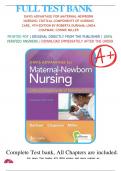FULL TEST BANK
DAVIS ADVANTAGE FOR MATERNAL-NEWBORN
NURSING: CRITICAL COMPONENTS OF NURSING
CARE, 4TH EDITION BY ROBERTA DURHAM; LINDA
CHAPMAN; CONNIE MILLER
PRINTED PDF | ORIGINAL DIRECTLY FROM THE PUBLISHER | 100%
VERIFIED ANSWERS | DOWNLOAD IMMEDIATELY AFTER THE ORDER
Complete Test bank, All Chapters are included.
For more Test banks, ATI, HESI exams, and more contact us.
,TABLE OF CONTENTS
Maternity NURSING Overview
1. Trends and Issues
2. Ethics and Standards of Practice Issues
The Antepartal Period
3. Genetics, Conception, Fetal Development, and Reproductive
Technology
4. Physiological Aspects of Antepartum Care
5. The Psycho-Social-Cultural Aspects of the Antepartum Period
6. Antepartal Tests
7. High-Risk Antepartum NURSING Care
Intrapartal Period
8. Intrapartum Assessment and Interventions
9. Fetal Heart Rate Assessment
10. High-Risk Labor and Birth
11. Intrapartum and Postpartum Care of the Cesarean Birth Families
Postpartal Period
12. Postpartum Physiological Assessments and NURSING Care
13. Transition to Parenthood
14. High-Risk Postpartum NURSING Care
Neonatal Period
15. Physiological and Behavioral Responses of the Neonate
16. Discharge Planning and Teaching
17. High-Risk Neonatal NURSING Care
Women’s Health
18. Well Women’s Health
19. Alterations in Women’s Health
,Chapter 1: Trends and Issues
MULTIPLE CHOICE
1. The nurse is caring for a patient who is in labor with her first child. The patient’s mother is
present for support and notes that things have changed in the delivery room since she last
gave birth in the early 1980s. Which current trend or intervention may the patient’s mother
find most different?
1. Fetal monitoring throughout labor
2. Postpartum stay of 10 days
3. Expectant partner and family in operating room for cesarean birth
4. Hospital support for breastfeeding
ANS: 4
Chapter: Chapter 1 Trends and Issues
Chapter Learning Objective: 1. Discuss current trends in the management of labor and birth
Page: 4
Heading: Table 1-1: Past and Present Trends
Integrated Processes: NURSING Process
Client Need: Health Promotion and Maintenance
Cognitive Level: Application [Applying]
Concept: Evidence-Based Practice
Difficulty: Moderate
Feedback
1 This is incorrect. Fetal monitoring during labor began in the late 1970s. As such,
this likely would have occurred during the mother’s labor and delivery during
the 1980s.
2 This is incorrect. In the past, the average hospital postpartum stay was 10 days.
Presently, the average postpartum stay is 48 hours or less.
3 This is incorrect. In the past, expectant partners and families were excluded from
the labor and birth experience. Present trends involve the expectant partner and
family in the labor and birth experience, including presence in the operating
room for cesarean births.
4 This is correct. Hospital support for breastfeeding, including a lactation
consultant and employment of the Baby-Friendly Hospital Initiative, were both
enacted during the early 1990s.
PTS: 1 CON: Evidence-Based Practice
2. A patient with a history of hypertension is giving birth. During delivery, the staff was not
able to stabilize the patient’s blood pressure. As a result, the patient died shortly after
delivery. This is an example of what type of death?
1. Early maternal death
2. Late maternal death
, 3. Direct obstetric death
4. Indirect obstetric death
ANS: 4




